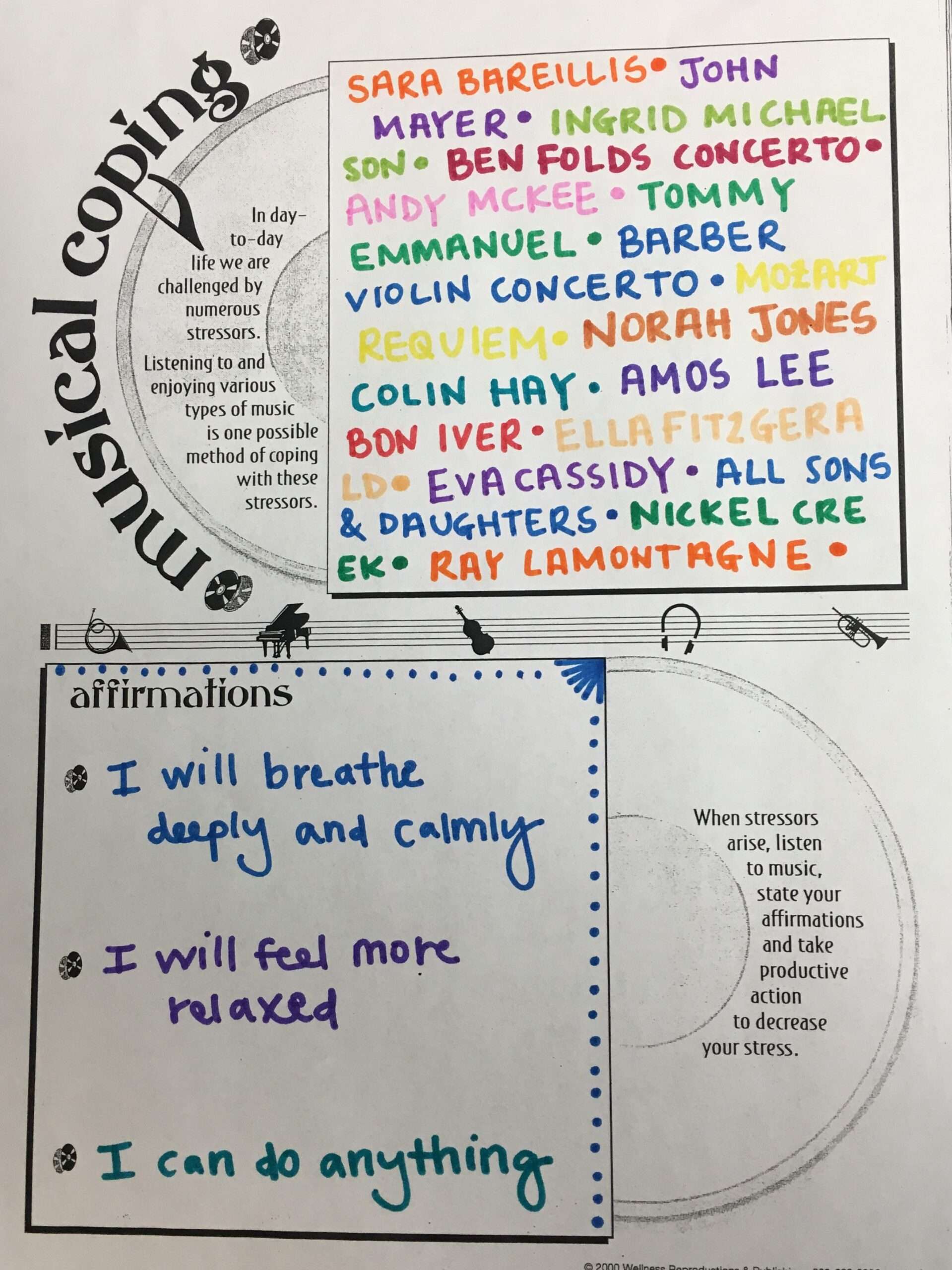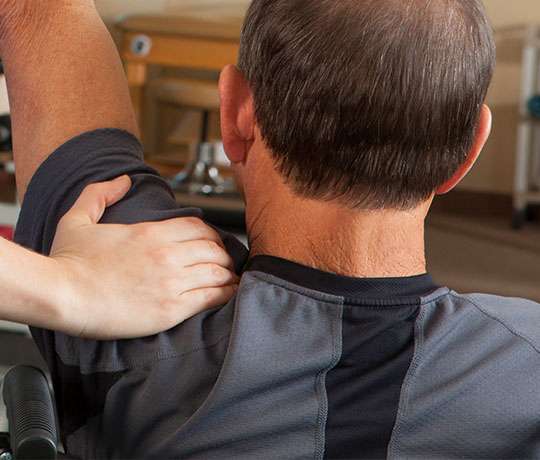It’s been a few months since I’ve shared some original intervention ideas for mental health. Within the music therapy world, we don’t often have the opportunity to share ideas and build off of one another. I think it’s important to create a resource for other music therapists to see each other’s work and ideas, which is the purpose of my Ideas & Resources page. Any of my ideas below, I give you permission to use because it is important that we support one another. Plus, I often find that I need inspiration and new ideas to spark my own creativity when I’m feeling burnt out on particular session plans and interventions. For those of you who aren’t MTs, consider this an inside look as to what some music therapy groups look like and their purposes.
INTERVENTION RESOURCE #11
“Draw What You Hear“
Goals: To increase creative expression; self-awareness; communication skills

Intervention: I begin this session by asking patients to rate themselves on their ability to listen. I prompt them with instructions to listen to 6 different instrumental songs of varying styles and sounds, each for approximately 3 minutes. I provide each patient with a worksheet, divided into 6 rectangles. I instruct them to take time to listen to the music and to either draw, write, or journal things they hear within the music (using one rectangle for each song). Since the music is instrumental, this idea is more abstract and uses imagination and close listening. Patients are provided with coloring/writing utensils and informed that there are no “correct” ways to go about this exercise. Patients are asked to be quiet and respectful throughout the exercise.
Considerations: Consider choosing instrumental songs that are mainstream enough that capture patients’ attention, but are not distracting or overly familiar (e.g. Pierrot Lunaire would not be appropriate or comforting). Some suggestions include score music from Disney Pixar movies (I am quite partial to “Define Dancing” from Wall-E) and other familiar orchestral works like Gershwin’s “Rhapsody in Blue”, Copland’s “Fanfare for the Common Man” and the like.
Adaptations: This is an idea that I came across a few years ago but have no idea where from. I first used this idea with pediatrics for creative expression but realized it is an important exercise for adults in psychiatric care. Simply choose age-appropriate and complex music to make this a worthwhile exercise. I would not use this with adults actively responding to internal stimuli (hallucinations, delusions) or with a history of dementia. [Or, I would adapt appropriately and change the takeaway and goals of the intervention].
Takeaway: After patients conclude listening to the excerpts, I then ask them to share what they came up with. Each patient takes a turn sharing, and often sparks comments or conversations between peers about the work they created. Facilitate this into a conversation about how we each hear and perceive the same information differently. Ask them to assess their listening skills compared to others in the room and how this might speak to some of their relationships or they kind of listeners they seek in their lives. We end by circling back to their assessment of their listening skills and leave with the question of what they could do to be a stronger listener.
INTERVENTION RESOURCE #12
“Hand[s] in [Our] Pocket[s]“
Goals: To increase self-awareness, emotional expression, autonomy, self-esteem
Intervention: This intervention relies heavily on a crowd-favorite, “Hand in My Pocket” by Alanis Morissette. I begin this session by asking patients to think of things they consider to be “in their control” and “out of their control”. I use an activity handout found in the resource Life Management Skills VI by Kathy L. Korb-Khalsa & Estelle A. Leutenberg that is in the shape of a blank hand. I ask patients to list the things that are in their control inside the hand, and things that are outside of their control outside of the hand. We then brainstorm a group version of this list and write it down on the whiteboard. I transition into a lyric analysis of the song, “Hand in My Pocket”, which includes themes of acceptance, moving forward, change, and control. I then give patients a lyric substitution worksheet and encourage them to think of their own version of a verse of the song, asking them to first identify something that is out of their control, and then something that is in their control as their way to cope. Example: “I’m broke but I’m happy” might be re-written as “I’m hurt but I’m coping”. Here’s a version of one group’s substitution.

Considerations: Patients often focus on their challenges and write two negatives in a row (e.g. “I’m broke but I’m unemployed”), so be sure to stress that they write the challenge first and then the way in which they’re coping with that challenge (“I’m broke but I’m loved”).
Adaptations: Have the patients write a group version of the lyric substitution to relieve the pressure of coming up with 6 of their own re-written lines of the song. This allows patients to determine only one line of the song within a group version.
Takeaway: Patients leave with a sense of self-worth and are often extremely proud of the group collaboration on their lyric substitution. It also challenges them to consider things that are within their control and aspects of their life they have the ability to change.
*This is by far my favorite session plan at the moment!
INTERVENTION RESOURCE #13
“Handbell Choir“
Goals: To decrease isolation, increase group cohesion, listening and communication skills
Intervention: Currently, I use this idea on our geriatric unit as a way to reminisce about being in a band/choir or taking music lessons. For those who did grow up involved in music, it is a nice way to revisit that feeling of being in an ensemble, and for those who do not, it’s a way to be included in something they hadn’t tried before. I use the West Music desk handbells and structure the group around playing simple, familiar tunes. I set up the “music” by using color and letter coded squares that correspond to the handbells on the whiteboard with magnet tape on the back. This allows me to rearrange the notes as needed and are easy to read based on either the color or the note name. I guide patients through reading the music on the board, practicing the song a couple of times, and choosing other songs to play. No matter their skill level, this always turns out well!

Considerations: Choose music that is basic and familiar enough that patients can easily follow along. Try not to choose music that is too young, but stick to standards. There often may not be time enough to teach about basic rhythm, so songs that have familiar or simple rhythm is also helpful. Make sure patients are also successfully arranged within the room so that they can see the music on the board!
Adaptations: Alter your choir as needed depending on the skill level or number of patients in the group. If you have advanced patients, have patients be in charge of two bells!
Takeaway: Playing within an ensemble gives the patients a sense of meaning and purpose. It challenges them to listen to one another and recognize each bell’s purpose within the choir. Often this intervention can lead to great discussions about communication and listening skills.
INTERVENTION RESOURCE #14
“Musical Coping“
Goals: To increase positive coping skills, self-awareness, creative expression

Intervention: This is another resource that I picked out from one of the Life Management Skills book. I liked this particular worksheet because it incorporated the idea of using music to cope paired with positive affirmations. I begin this session by leading a discussion about music as a coping skill and the benefits of music. I then guide patients through brainstorming some of the music they connect with and enjoy using to relax or to cope. I give them space to write down either a list of songs they would include on a relaxation, or “stress-free” CD/playlist, or encourage them to design the album artwork for such a CD (I also provide a list of suggested songs they can use or to spark their memory). The second part is to identify positive affirmations that they could tell themselves as they listen to their chosen music. Questions I might ask are, “What do you need to hear the most when you listen to this music?” or “What is a mantra you could repeat during a particular song to further your relaxation”? Afterwards, I allow patients to share anything they identified or created. I close the session with a brief guided breathing and music to further the example of music, coping, and relaxation.
Considerations: Patients will range in their attention and/or time with this exercise. By providing a suggested list of songs, patients who need more structure have something to guide them. An important consideration is those patients who hide behind their music. I have had patients who use music as a detriment to their health and their relationships. In one case, I suggested the patient create a list of songs that would encourage her to engage with the world. We changed her exercise to creating a”motivation playlist” where she could positively affirm herself so that by the end of the CD, she would get out of her music listening habits and engage in her relationships without hiding behind her music.
Adaptations: There are many different things you could do with these brainstormed lists. If you have the ability, you could provide actual CDs on which they could design album artwork. You could also create mix CDs for them based on their lists if you have the appropriate resources and permission.
Takeaway: Patients have the freedom for creative expression in writing, drawing, and brainstorming their ideas for this worksheet. It also gives them the opportunity to discuss their music preferences with you, the MT, and their peers. It also challenges them to reconsider the ways in which they already use music in their lives and how it can be an even more productive coping skill.
Extra: Songs I’m currently enjoying for Lyric Analyses (*some new, some old!)
- I’m Not the Man – Ben Folds
- Hold On – Wilson Phillips
- Burning Gold – Christina Perri
- Man in the Mirror – Michael Jackson
- Waiting for My Life to Begin – Colin Hay



